
Gaillardia is a genus of flowering plants in the family Asteraceae, native to North and South America. It was named after Maître Gaillard de Charentonneau, an 18th-century French magistrate who was an enthusiastic botanist. The common name may refer to the resemblance of the inflorescence to the brightly patterned blankets made by Native Americans, or to the ability of wild taxa to blanket the ground with colonies. Many cultivars have been bred for ornamental use.

Gaillardia pulchella is a North American species of short-lived perennial or annual flowering plants in the sunflower family.
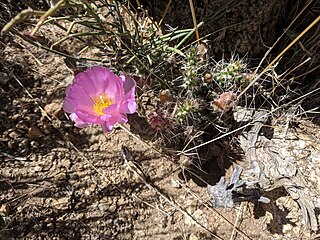
Grusonia pulchella (Engelm.) H.Rob., also known as sagebrush cholla, is a tuberous species of opuntioid cactus from the Mojave Desert of central Nevada, eastern California, northwestern Arizona and western Utah in the United States. Grusonia pulchella has at various times been included in Opuntia or placed in a separate genus Micropuntia.

Acacia pulchella, commonly known as prickly moses or western prickly moses, is a shrub in the family Fabaceae. Endemic to Western Australia, it is one of the most common shrubs of the bushland around Perth and in the Darling Range.

Banksia pulchella, commonly known as teasel banksia, is a species of small shrub that is endemic to the south-west of Western Australia. It has smooth grey bark, linear leaves and golden-brown flowers in short, cylindrical heads and inconspicuous follicles.
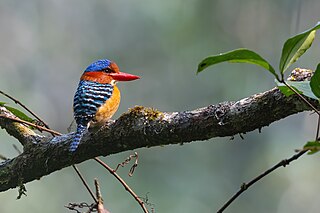
The banded kingfisher is a tree kingfisher found in lowland tropical forests of southeast Asia. It is the only member of the genus Lacedo. Male and female adults are very different in plumage. The male has a bright blue crown with black and blue banding on the back. The female has rufous and black banding on the head and upperparts.

The fairy lorikeet is a species of parrot in the family Psittaculidae. Other common names include the little red lorikeet and the little red lory. Found in New Guinea, its natural habitats are subtropical or tropical moist lowland forests and subtropical or tropical moist montane forests. Its colouration is mainly red with some yellow on the throat and green on the wings. Two subspecies are recognised, C. p. pulchella and C. p. rothschildi.

Utetheisa pulchella, the crimson-speckled flunkey, crimson-speckled footman, or crimson-speckled moth, is a moth of the family Erebidae. The species was first described by Carl Linnaeus in his 1758 10th edition of Systema Naturae.
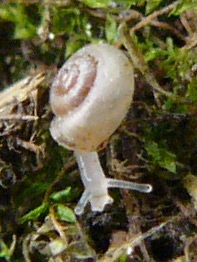
Vallonia pulchella, common name the lovely vallonia, is a species of very small air-breathing land snail, a terrestrial pulmonate gastropod mollusk in the family Valloniidae.

Pulchellidin (Pl) is an O-methylated anthocyanidin. It is a blue-red plant pigment. It can be found in Plumbago pulchella.

Libertia pulchella, the pretty grass-flag, is a plant in the iris family (Iridaceae). It is native to Papua New Guinea, New Zealand and Australia, where it occurs in New South Wales and Victoria and Tasmania. The flowering scape rises above the linear leaves producing 3 to 6 cream-coloured flowers.

Hypselodoris pulchella is a species of sea slug, a dorid nudibranch, a marine gastropod mollusk in the family Chromodorididae.
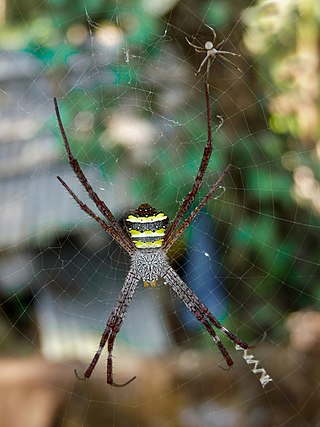
Argiope pulchella is a species of the orb-weaver spider family, Araneidae. It ranges from India to China and can be found on Java. It is a synanthropic species, often living in habitats associated with humans.

Melaleuca pulchella, commonly known as claw flower and claw honey-myrtle, is a plant in the myrtle family Myrtaceae, and is endemic to the south of Western Australia. It is one of only two species of Melaleuca to have two kinds of stamens. The outer stamens are longer and curved, giving the appearance of a claw to the flower. It is a hardy shrub flowering over a long period, and has been a popular garden plant for many years.

Petrophile pulchella, commonly known as conesticks, is a common shrub of the family Proteaceae and is found in eastern Australia. The leaves are divided with needle-shaped but soft pinnae, the flowers silky-hairy, cream-coloured and arranged in oval heads and the fruit are arranged in oval heads. Conesticks grows on shallow sandstone soils, often in open forest or heathlands near the coast. It is also occasionally seen on the adjacent ranges.
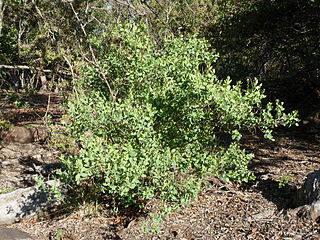
Clutia pulchella, the lightning bush, is a southern African dioecious shrub of the family Peraceae. It occurs at middle altitudes in Namibia, Mozambique, Zimbabwe, Eswatini, Botswana, Lesotho and South Africa.
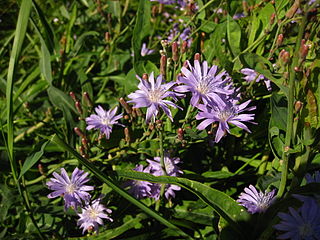
Lactuca tatarica, known as blue lettuce, is a Eurasian flowering plant in the tribe Cichorieae within the family Asteraceae. It is widespread across much of Europe and Asia.
Alstroemeria pulchella is a scientific name that may refer to the following plants commonly referred to as Peruvian lilies:

Elephantomyia (Elephantomyia) pulchella is an extinct species of crane fly in the family Limoniidae. The species is solely known from the Middle Eocene Baltic amber deposits in the Baltic Sea region of Europe. The species is one of six described from Baltic amber.
Morchella pulchella is a species of fungus in the family Morchellaceae that was described as new to science in 2012. It is found in France, where it grows on calcareous soil under Buddleja davidii.
















